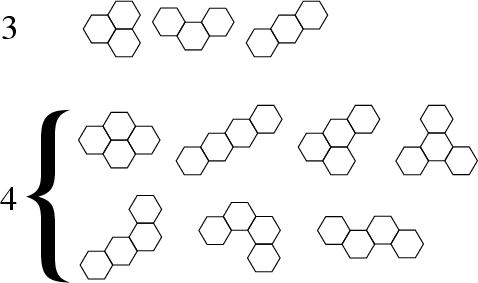|
|
|

An analog of the Polyominoes and Polyiamonds in which collections of regular
hexagons are arranged with adjacent sides. They are also called Hexes and Hexas.
The number of polyhexes of ![]() hexagons are 1, 1, 3, 7, 22, 82, 333, 1448, 6572, 30490, 143552, 683101, ...
(Sloane's A000228). For the
4-hexes (tetrahexes), the possible arrangements are known as the Bee, Bar, Pistol,
Propeller, Worm, Arch, and Wave.
hexagons are 1, 1, 3, 7, 22, 82, 333, 1448, 6572, 30490, 143552, 683101, ...
(Sloane's A000228). For the
4-hexes (tetrahexes), the possible arrangements are known as the Bee, Bar, Pistol,
Propeller, Worm, Arch, and Wave.
References
Gardner, M. ``Polyhexes and Polyaboloes.'' Ch. 11 in
Mathematical Magic Show: More Puzzles, Games, Diversions, Illusions and Other Mathematical Sleight-of-Mind from Scientific American. New York: Vintage,
pp. 146-159, 1978.
Gardner, M. ``Tiling with Polyominoes, Polyiamonds, and Polyhexes.'' Ch. 14 in Time Travel and Other
Mathematical Bewilderments. New York: W. H. Freeman, pp. 175-187, 1988.
Golomb, S. W. Polyominoes: Puzzles, Patterns, Problems, and Packings, 2nd ed.
Princeton, NJ: Princeton University Press, pp. 92-93, 1994.
Sloane, N. J. A. Sequence
A000228/M2682
in ``An On-Line Version of the Encyclopedia of Integer Sequences.''
http://www.research.att.com/~njas/sequences/eisonline.html and Sloane, N. J. A. and Plouffe, S.
The Encyclopedia of Integer Sequences. San Diego: Academic Press, 1995.
von Seggern, D. CRC Standard Curves and Surfaces. Boca Raton, FL: CRC Press, pp. 342-343, 1993.